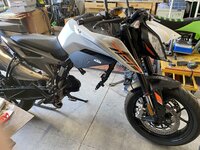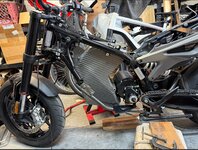I am planning an electric conversion and have read a lot here and endless-sphere so thank you to everyone who has provided information in both places. I'd be lost without it!
I have read that most of @DonCox builds use 72 volt batteries (often as 20S12P) and it seems like a popular choice. @fmxxx666 went slightly higher and electro & co bump things slightly as well to 76v.
Based on my calculations, the difference in watt hours between 26S9P and 20S12P are pretty small (only a couple hundred watt hours). But, 26S has the obvious benefit of requiring less current for the same power and all the good stuff that goes along with that. Edit: Here is an example at amorge of a comparison of 20S10P and 26S7P which shows the watt hour difference between those two.
The main reason I can see to consistently choose 72v are that the controllers are cheaper. But, at $273 for an EM260 $535 for an ND96850, I would not see that as a large part of the equation. Especially since it would help alleviate some of the heat build up. I would think any power/torque curve difference the higher voltage would introduce could be managed with different sprocket gearing.
Why is 72 volts chosen so consistently especially by people like @DonCox who are clearly very knowledgeable and experienced at this.
Are 96 volt batteries more expensive? Am I wrong about simply using the sprocket gearing to move the power down with 96 volts? I feel like I'm missing something b/c 72 volts is so popular.
I'll be sticking with 72 on my first build since it is a KLX400 which I got free and has a bad motor and isn't a great fit with its non spar frame. So, it will be a budget build for my first go. But, I'm wondering in general and obviously thinking I'll try again on another bike.
Thanks!
I have read that most of @DonCox builds use 72 volt batteries (often as 20S12P) and it seems like a popular choice. @fmxxx666 went slightly higher and electro & co bump things slightly as well to 76v.
Based on my calculations, the difference in watt hours between 26S9P and 20S12P are pretty small (only a couple hundred watt hours). But, 26S has the obvious benefit of requiring less current for the same power and all the good stuff that goes along with that. Edit: Here is an example at amorge of a comparison of 20S10P and 26S7P which shows the watt hour difference between those two.
The main reason I can see to consistently choose 72v are that the controllers are cheaper. But, at $273 for an EM260 $535 for an ND96850, I would not see that as a large part of the equation. Especially since it would help alleviate some of the heat build up. I would think any power/torque curve difference the higher voltage would introduce could be managed with different sprocket gearing.
Why is 72 volts chosen so consistently especially by people like @DonCox who are clearly very knowledgeable and experienced at this.
Are 96 volt batteries more expensive? Am I wrong about simply using the sprocket gearing to move the power down with 96 volts? I feel like I'm missing something b/c 72 volts is so popular.
I'll be sticking with 72 on my first build since it is a KLX400 which I got free and has a bad motor and isn't a great fit with its non spar frame. So, it will be a budget build for my first go. But, I'm wondering in general and obviously thinking I'll try again on another bike.
Thanks!



